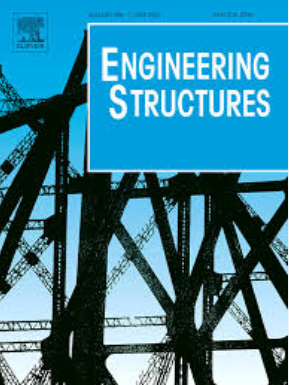方钢管混凝土短柱轴压作用下的尺寸效应特性
IF 5.6
1区 工程技术
Q1 ENGINEERING, CIVIL
引用次数: 0
摘要
对14个方形钢管混凝土(CFST)试件进行了轴压作用下的尺寸效应试验。试件的截面宽度从156 mm到1040 mm不等,包括实验室和实际工程尺寸。分析了方钢管混凝土柱的破坏模式、峰值应力状态以及复合弹性模量、峰值轴向应力应变和延性系数等重要力学特性,重点分析了截面宽度和配钢比对方钢管混凝土柱的影响。与素体混凝土相比,由于钢管的作用,方钢管混凝土柱在峰值轴向应力下的尺寸效应减弱。随着截面宽度的增大,峰值轴向应变、残余承载力0.85Nu时的应变和延性系数也呈减小趋势。最后,通过对钢管和混凝土芯轴向应力的分析,提出了承载力的预测公式,并通过试验数据进行了验证。并与现行规范ACI、EC4和GB50936的预测精度进行了比较。本文章由计算机程序翻译,如有差异,请以英文原文为准。
Size effect behavior of square concrete-filled steel tubular short columns under axial compression
Fourteen square concrete-filled steel tubular (CFST) specimens were fabricated and tested to investigate the size effect behavior under axial compression. The sectional widths of the specimens ranged from 156 mm to 1040 mm, encompassing both laboratory and practical engineering scales. The failure modes, stress state at peak load, and the vital mechanical characteristics, like composite elastic modulus, peak axial stress and strain, and the ductility coefficient, were analyzed to highlight the influences of both sectional width and steel ratio of square CFST columns. Compared to plain concrete, the size effect of square CFST columns in peak axial stress is weakened thanks to the contribution of steel tubes. Moreover, the peak axial strain, the strain at a residual bearing capacity of 0.85Nu, and the ductility coefficient also present a decreasing trend as the sectional width increases. Finally, a formula for predicting the bearing capacity is proposed by analyzing the axial stresses of the steel tube and concrete core, which is validated by the test data. The prediction accuracy is also compared with that from the current codes of ACI, EC4, and GB50936.
求助全文
通过发布文献求助,成功后即可免费获取论文全文。
去求助
来源期刊

Engineering Structures
工程技术-工程:土木
CiteScore
10.20
自引率
14.50%
发文量
1385
审稿时长
67 days
期刊介绍:
Engineering Structures provides a forum for a broad blend of scientific and technical papers to reflect the evolving needs of the structural engineering and structural mechanics communities. Particularly welcome are contributions dealing with applications of structural engineering and mechanics principles in all areas of technology. The journal aspires to a broad and integrated coverage of the effects of dynamic loadings and of the modelling techniques whereby the structural response to these loadings may be computed.
The scope of Engineering Structures encompasses, but is not restricted to, the following areas: infrastructure engineering; earthquake engineering; structure-fluid-soil interaction; wind engineering; fire engineering; blast engineering; structural reliability/stability; life assessment/integrity; structural health monitoring; multi-hazard engineering; structural dynamics; optimization; expert systems; experimental modelling; performance-based design; multiscale analysis; value engineering.
Topics of interest include: tall buildings; innovative structures; environmentally responsive structures; bridges; stadiums; commercial and public buildings; transmission towers; television and telecommunication masts; foldable structures; cooling towers; plates and shells; suspension structures; protective structures; smart structures; nuclear reactors; dams; pressure vessels; pipelines; tunnels.
Engineering Structures also publishes review articles, short communications and discussions, book reviews, and a diary on international events related to any aspect of structural engineering.
 求助内容:
求助内容: 应助结果提醒方式:
应助结果提醒方式:


